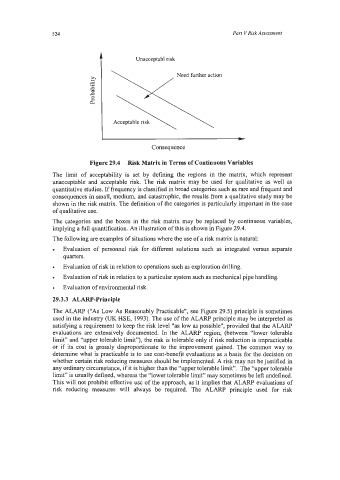Page 548 - Marine Structural Design
P. 548
524 Part V Risk Assessment
k Unacceptabl risk
1 Acceptablerisk \
-
Consequence
Figure 29.4 Risk Matrix in Terms of Continuous Variables
The limit of acceptability is set by defining the regions in the matrix, which represent
unacceptable and acceptable risk. The risk matrix may be used for qualitative as well as
quantitative studies. If frequency is classified in broad categories such as rare and frequent and
consequences in small, medium, and catastrophic, the results from a qualitative study may be
shown in the risk matrix. The definition of the categories is particularly important in the case
of qualitative use.
The categories and the boxes in the risk matrix may be replaced by continuous variables,
implying a full quantification. An illustration of this is shown in Figure 29.4.
The following are examples of situations where the use of a risk matrix is natural:
Evaluation of personnel risk for different solutions such as integrated versus separate
quarters.
Evaluation of risk in relation to operations such as exploration drilling.
Evaluation of risk in relation to a particular system such as mechanical pipe handling.
Evaluation of environmental risk.
29.3.3 ALARP-Principle
The ALARF’ (“As Low As Reasonably hacticable”, see Figure 29.5) principle is sometimes
used in the industry (UK HSE, 1993). The use of the ALARP principle may be interpreted as
satisfying a requirement to keep the risk level “as low as possible”, provided that the ALARP
evaluations are extensively documented. In the ALARP region, (between “lower tolerable
limit” and “upper tolerable limit”), the risk is tolerable only if risk reduction is impracticable
or if its cost is grossly disproportionate to the improvement gained. The common way to
determine what is practicable is to use cost-benefit evaluations as a basis for the decision on
whether certain risk reducing measures should be implemented. A risk may not be justified in
any ordinary circumstance, if it is higher than the “upper tolerable limit”. The “upper tolerable
limit” is usually defined, whereas the “lower tolerable limit” may sometimes be left undefined.
This will not prohibit effective use of the approach, as it implies that ALARP evaluations of
risk reducing measures will always be required. The ALARP principle used for risk

